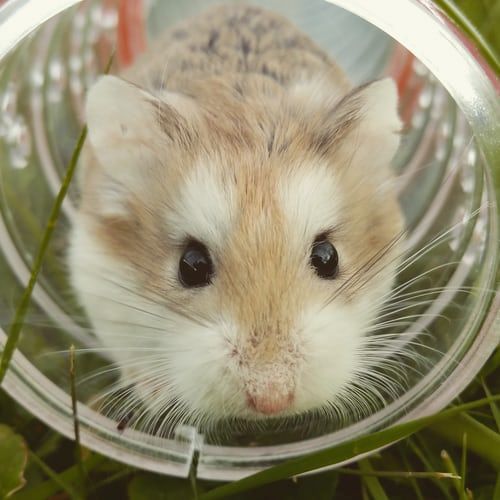40 Interesting facts about hamsters
Hamsters are small creatures. They are often kept as a pet. Here are 40 interesting facts about hamsters you may or may not have known about and if you didn’t well now you do!
1. Hamsters Scientific name is Mesocricetus auratus.
2. Potential life span 2-3 years.
3.Adult Hamsters bodyweight is almost 100-150 grams.
4.Temperature range 65-75 F.
5.Humidity range 30-70%.
6. At 1st breeding male: 10-14 weeks; female: 6-10 weeks.
7.Length of estrous (heat) cycle 94 hours.
8.Average litter size 5-10 young.
9.Hamsters can store food into their cheeks up to 20 % of their body weight.
10.Hamsters can run at 2-3 mph for long distances and 5-7 mph for short distances.
11.Hamsters can travel about 8 miles in search of food.
12.Hamsters react to their names.
13.Hamsters are color blind.
14.Hamsters can hear sound in the Ultrasonic range.
15.Hamsters can dig up to 3 Meters in the wild.
16.Hamsters can only see up to 6 inches in front of them.
17.Hamsters can store almost 38 pounds of grain in a single burrow.
18.Hamsters follow a path by trails of smell they leave by rubbing their body with things along the path.
19. Hamster’s heartbeat falls from 400-4 beats per minute during hibernation state.
20.There are many different wild species out there including the European hamster but only 5 hamsters breeds are domesticated and that includes the Syrian hamster, Chinese hamster, Roborovski, winter white, and Campbell dwarf.
21. Syrians were first named in 1839 and they were first brought to the US in 1971.
22. Hamster remembers their relatives.
23.The word hamster comes from the German word hamsters which means to hoard because hamsters hoard food in their cheek pouches they bring it back to their nest and they create very large hoards.
24. hamsters have 16 teeth that include 4 incisors and 12 molars.
25. hamsters are omnivores which means they can eat a variety of different foods such as seeds, grains, nuts, fruits, and vegetables as well as animal proteins like lean cooked meats as well as insects.
26. hamsters cannot catch a common cold as Rhinovirus is not zoonotic so if you come down with the cold you can still interact with your hamster without worrying about them getting sick.
27. hamsters are illegal in places like Australia and Hawaii since their climates very like hamsters and they are concerned that if a hamster were to escape that they could create wild colonies which could cause damage to native plants and animals.
28. hamsters have pregastric pouches which allow them to digest the lactose enzymes which means hamsters can have dairy, unlike other animals.
29. hamsters can travel up to5 miles in a night in the wild.
30. hamsters are solitary animals and do best on their own.
31. hamsters cannot hibernate in captivity and doing so can lead to death.
32. hamsters can start reproducing as young as 4 weeks of age.
33. A healthy hamster's teeth will be a yellow/orange color. If your hamsters' teeth are white that can be a sign of stress or malnutrition.
34. hamsters don’t drink a ton of water due to the fact of where they originate from.
35. Syrian hamsters in the wild are considered to be on the vulnerable list due to increased agriculture.
36. Hamsters have 4 toes on their front feet and 5 toes on their back feet.
37. A Syrian hamster cannot be crossbred with a dwarf hamster because they are different species, same goes for if you tried to breed a Chinese hamster with a dwarf hamster it’s not possible since they just aren’t the same species.
38. Syrian hamsters and Chinese hamsters were used for human medical research.
39. hamsters use their scent glands on their hips to help mark items so that they can find their way back when they travel far.
40. hamsters produce 2 different types of poops and one of these poops they eat because helps them to reabsorb any nutrients they missed when they were first digesting them.
We have provided 40 Interesting facts about Hamsters. If you know the other amazing facts about Hamsters. Tell us within the comment section below.
ALSO READ > All About Hamster Diet: Hygiene, Family & Diseases









0 Comments
please do not enter any spam link in the comment.